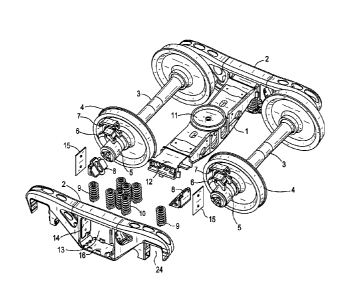Note: Claims are shown in the official language in which they were submitted.
What is claimed is:
1. A friction shoe for a railway car truck,
the railway car truck comprising
two parallel sideframes, a suspension spring assembly supported by the
sideframes, and a
bolster transversely mounted between the sideframes and supported by the
suspension spring
assembly,
each sideframe having at least one vertical column,
the bolster having at least one sloped wall,
the friction shoe comprising:
a bottom surface engaging and supported by a suspension control spring,
a sloped face engaging the sloped wall of the bolster,
and a vertical face including a liner pocket,
a friction liner bonded in the liner pocket on the vertical face of the
friction shoe,
the friction liner engaging the vertical column of the sideframe,
the friction shoe friction liner provides a damping force of between 7500 and
16,250
pounds when the friction shoe is moving downward at a velocity of between 0
and 19 inches per
second.
2. The friction shoe of claim 1 wherein
the friction shoe friction liner comprised of a material providing a normal
force of
between 2000 and 12,000 pounds.
3. The friction shoe of claim 1 wherein
the friction liner is a molded material such as RF-55.
4. The friction shoe of claim 1 wherein
the friction liner is comprised of one or more of the following:
carbon/graphite, ceramic, or polymer blend material.
5. The friction shoe of claim 1 wherein
the friction liner is comprised of sintered iron or alloyed steel.
6. The friction shoe of claim 1 wherein
the friction liner is bonded without a pocket on the friction shoe body or un-
bonded with
a pocket in the friction shoe body.
7. A friction shoe for a railway car truck,
the railway car truck comprising
two parallel sideframes, a suspension spring assembly supported by the
sideframes, and a
bolster transversely mounted between the sideframes and supported by the
suspension spring
assembly,
each sideframe having at least one vertical column,
the bolster having at least one sloped wall,
the friction shoe comprising:
a bottom surface engaging and supported by a suspension control spring,
6
a sloped face engaging the sloped wall of the bolster,
and a vertical face including a liner pocket,
a friction liner bonded in the liner pocket on the vertical face of the
friction shoe,
the friction liner engaging the vertical column of the sideframe,
the friction shoe friction liner comprised of a material providing a damping
force of
between 700 and 10,000 pounds when the friction shoe is moving upward at a
velocity of
between 0 and 19 inches per second.
8. The friction shoe of claim 7 wherein
the friction shoe friction liner comprised of a material providing a normal
force of
between 2000 and 12,000 pounds.
9. The friction shoe of claim 1 wherein
the friction liner is a molded material such as RF-55.
10. The friction shoe of claim 7 wherein
the friction liner is comprised of one or more of the following:
carbon/graphite, ceramic, or polymer blend material.
11. The friction shoe of claim 7 wherein
the friction liner is comprised of sintered iron or alloyed steel.
12. The friction shoe of claim 7 wherein
7
the friction liner is bonded without a pocket on the friction shoe body or un-
bonded with
a pocket in the friction shoe body.
8
